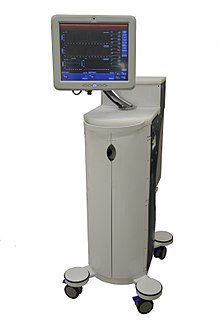Liquid ventilation

Liquid ventilation (engl. Liquid ventilation ) refers to a form of the ventilator , wherein the patient instead of breath one with oxygen -enriched liquid from the family of perfluorocarbons breathe.
Development history
Early experiments took place at State University in New York in the mid-1960s . Since then, research on mice has repeatedly shown advances in application. Clinical studies on humans have been taking place since 1990. Here comes perflubron alias LiquiVent used.
Advantages and disadvantages
The most important advantage of liquid ventilation is the lowering of the surface tension of the lung alveoli ; the reduced surface tension prevents the alveoli from collapsing, so that larger areas of the lungs are once again involved in gas exchange. The difficult exhalation of carbon dioxide and the damage to the lung tissue by the medium have a disadvantageous effect ; liquids attack the protective mucous membrane and make it much more susceptible to infections of the respiratory tract (e.g. pneumonia ). Due to the higher density and viscosity of the perfluorocarbon, the airway resistance and thus the work of breathing increase.
application
overview
Fluid ventilation is used in premature babies and adults with severe lung damage.
Another possible application could be diving . The breathing of liquid overcomes the well-known pressure problems here.
Although perfluorocarbons have a convincing effect on the ventilation of patients with Acute Respiratory Distress Syndrome (ARDS) in many case reports , no standard application for perfluorocarbons (PFC) has yet been established. Due to the great technical complexity and the risks for the patient, there are considerable concerns about both “complete fluid ventilation” and “partial fluid ventilation”.
Various forms of liquid ventilation (ventilation with perfluorocarbon ) have currently been described:
- Complete liquid ventilation (TLV "Total liquid ventilation")
- Partial liquid ventilation (PLV)
- Perfluorocarbon vapor ventilation
- Aerosol PFC
Complete fluid ventilation
A special ventilator is used for complete fluid ventilation (TLV) with a complete PFC filling of the lungs. This contains liquid pumps, a membrane oxygenator, a heating device and a liquid-filled hose system. Pure liquid breaths are applied for ventilation. (That is why TLV is sometimes translated as "Tidal Liquid Ventilation", tidal is derived from Tide ) Although theoretically a clear concept speaks for the successful use of this ventilation, the practicality of the TLV has so far been put into perspective by the complicated structure and the technically complex procedure.
Partial fluid ventilation
Partial liquid ventilation (PLV) can be performed with a standard ventilator and a breathing gas-filled hose system. The functional residual capacity of the lungs (i.e., the volume that normally remains air-filled after exhalation) is filled with perfluorocarbon and gas tidal volumes are applied to the intrapulmonary perfluorocarbon level as in conventional gas ventilation . The influence of PLV on gas exchange and lung mechanics was investigated in several animal studies using different models of lung failure. Clinical application observations of PLV are available for ARDS, meconium aspiration syndrome (MAS), congenital diaphragmatic hernia and respiratory distress syndrome in premature babies (iRDS). The use of the PLV, especially maintaining the PFC fill volume, requires extreme care. In a phase 3 study on adults with ARDS that was discontinued in 2002 (320 patients with PLV included, not published), both the filling process and the monitoring of the filling volume proved to be extremely difficult. In addition, there are considerable uncertainties about the setting of the ventilation parameters. For example, changes in the respirator parameters due to the PFC filling have different effects on the lungs than is known from gas ventilation. In addition, there are different effects on gas or liquid-filled lung areas of a patient.
Perfluorocarbon vapor ventilation
Alternative ventilation with perfluorocarbon is possible through the use of highly volatile substances. Perfluorohexane evaporates at room temperature and can be mixed into the breathing air in a controlled manner using a modified anesthetic gas evaporator. The effects of this application seem to correspond to those of the PLV. The strict limitation to perfluorocarbons with very high vapor pressure limits the choice of suitable substances considerably. The significance of extra-alveolar, vacuolar inclusions after experimental ventilation with perfluorohexane is currently unclear.
See also
Individual evidence
- ↑ JU Bleyl, M. Ragaller, U. Tschö, M. Regner, M. Kanzow, M. Hübler, S. Rasche, M. Albrecht: Vaporized perfluorocarbon improves oxygenation and pulmonary function in an ovine model of acute respiratory distress syndrome. In: Anesthesiology. Volume 91, Number 2, August 1999, pp. 461-469, ISSN 0003-3022 . PMID 10443610 .